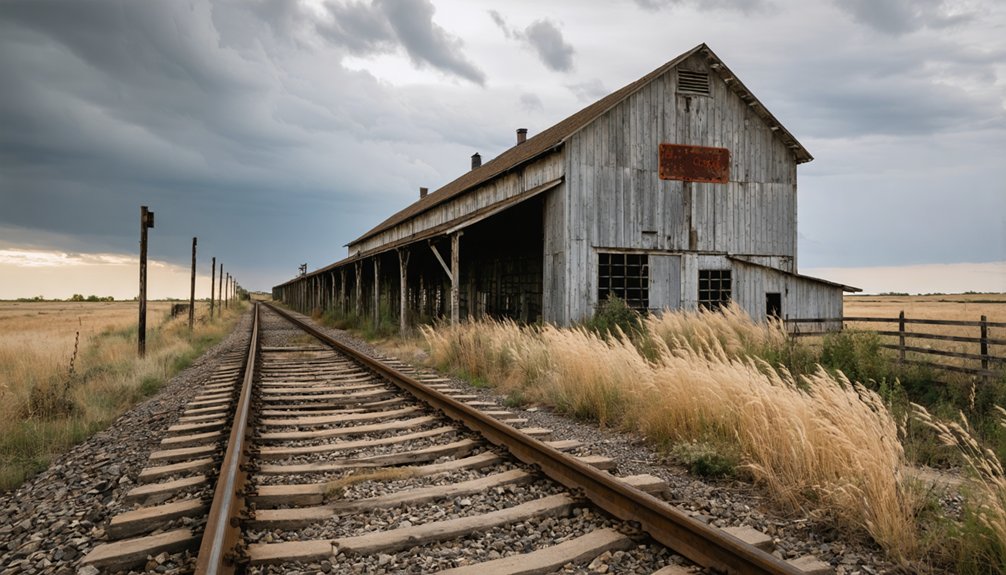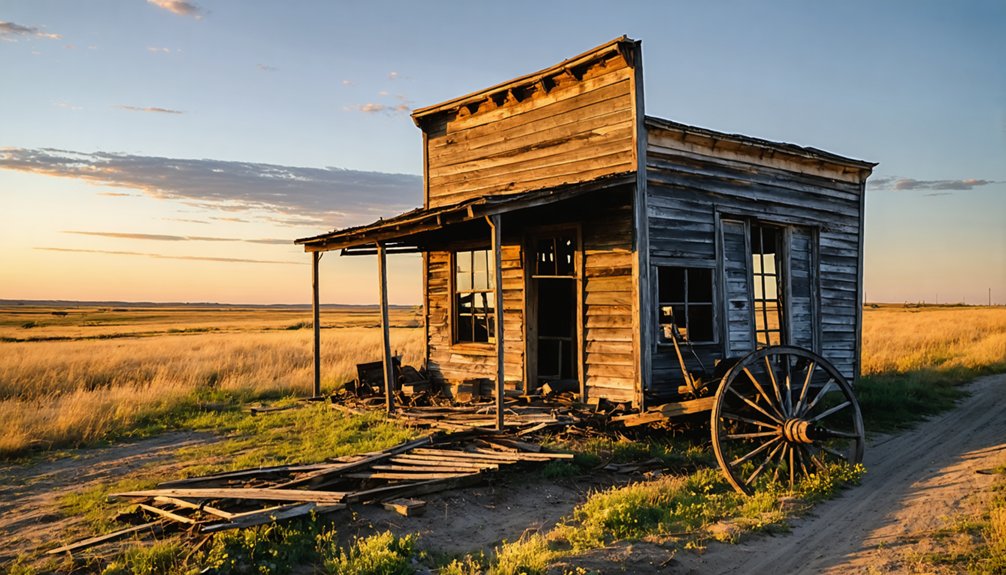You’ll find Winship, South Dakota 7 miles north of Frederick in Brown County, where it emerged as a railroad station in 1881 along the Chicago, Milwaukee, St. Paul, and Pacific Railroad line. Despite its peak population of only eight residents, the town served as an essential agricultural hub with two grain elevators, a creamery, and stockyards. After the Milwaukee Road’s bankruptcy in 1980, Winship faded into ghost town status, though its pioneer spirit still echoes across the rolling plains.
Key Takeaways
- Winship is a ghost town in Brown County, South Dakota that emerged from a railroad station but never exceeded eight residents.
- The town’s decline began by 1930 and accelerated after the Chicago, Milwaukee, St. Paul and Pacific Railroad’s bankruptcy in 1980.
- Located 7 miles north of Frederick, Winship served as a transportation hub with two grain elevators and agricultural facilities.
- Today, only a few occupied homes remain near the former town site, with no original structures from its railroad-era past.
- The ghost town’s legacy represents the broader pattern of railroad community rise and decline in South Dakota’s border regions.
The Rise of a Railroad Station
While many South Dakota towns flourished along railroad lines in the late 1800s, Winship emerged as a small but hopeful station on the Chicago, Milwaukee, St. Paul, and Pacific Railroad line.
You’ll find this ambitious development north of Frederick, where the railroad’s impact promised to transform the prairie landscape into a bustling community.
Like many sooners and railroad companies, settlers rushed to establish towns along anticipated rail routes during this period.
In 1889, the area’s community aspirations took shape with the construction of a schoolhouse, followed by the establishment of two grain elevators.
These developments suggested Winship’s potential as an agricultural hub, though you’d only find about eight residents at its peak.
By 1930, the town’s decline became evident when one elevator remained of the original pair.
Despite never gaining a post office, the railroad station’s presence made it possible for local farmers to transport their grain efficiently, marking Winship’s brief moment of promise in South Dakota’s railroad era.
Location and Geographic Features
If you’re heading north on US Highway 281 toward North Dakota, you’ll find Winship’s ghost town site about 7 miles north of Frederick in Osceola Township, Brown County.
As a border community near North Dakota, Winship’s strategic position made it an ideal transportation hub along the Chicago, Milwaukee, St. Paul and Pacific Railroad line that operated from 1881 to 1980. The town’s early economy revolved around two grain elevators that served local farmers. Like Okaten, the town faced severe decline after the Milwaukee Road bankruptcy in 1980.
The town’s location at the intersection of crucial rail and road routes created perfect conditions for moving grain from the surrounding prairie farmlands to larger markets.
Border Community Positioning
Although Winship, South Dakota lies firmly within Brown County‘s boundaries, it doesn’t exhibit typical border community characteristics. You won’t find the bustling cross-border trade or cultural exchange that’s common in towns near state lines.
Instead, Winship developed its community identity as a rural farming hub, focused on serving the agricultural needs of the surrounding prairie lands. Situated approximately seven miles north of Frederick, the town’s position made it convenient for area farmers. Similar to many sites in disrepair, Winship’s remaining structures tell the story of its agricultural past.
Unlike border towns that thrive on interstate commerce, Winship’s role centered on its position along the Chicago, Milwaukee and St. Paul railroad line. While this rail connection helped local farmers transport their grain to market, it didn’t establish Winship as a significant border crossing point.
The town’s location well within South Dakota’s interior shaped its destiny as a purely local service center rather than a gateway community.
Transportation Hub Access
Situated along the Chicago, Milwaukee, St. Paul and Pacific Railroad, Winship’s transportation hub status thrived from 1881 until its decline in 1980.
You’ll find this ghost town nestled in Osceola Township’s rolling plains, where rail and road infrastructure once seamlessly connected local farmers to regional markets. Today, like many other neglected South Dakota sites, only remnants of its transportation legacy remain visible.
- Two grain elevators served as essential loading points for agricultural shipments
- A strategic highway location complemented the rail service
- Stockyards and a creamery supported livestock transportation
- The depot facilitated both passenger and freight movement
After the railroad’s closure, accessibility challenges intensified despite the nearby highway presence. The systematic mapping of abandoned settlements across the state revealed similar transportation-related decline patterns.
The transportation decline proved devastating – without the railway’s economic lifeline, Winship’s role as an agricultural shipping center couldn’t survive on road access alone, contributing to its eventual abandonment.
Life Along the Milwaukee Road
During the late 1800s, life along the Milwaukee Road transformed South Dakota’s frontier landscape into a network of bustling agricultural communities.
You’d find towns sprouting up every 5-10 miles along the tracks, each one an essential link in the railroad culture that connected farmers to distant markets. When you lived in these communities, the local depot wasn’t just a building – it was your gateway to the wider world.
The railroad brought more than just transportation; it created community connections that defined daily life. You could ship your grain and livestock to Chicago, catch the Olympian Hiawatha for business in Minneapolis, or gather at the depot to exchange news with neighbors. Railroad superintendent Charles Prior supervised construction of this vital transportation network into the Dakotas.
These towns became vibrant social and commercial hubs, with the rhythmic sound of passing trains marking time in the prairie’s endless expanse. The Milwaukee Road’s extensive network reached its peak in 1929 when it operated 11,248 miles of track across the region.
Agriculture and Commerce
During harvest season, you’d find Winship’s grain storage operations bustling with activity as farmers brought their wheat and corn harvests to the local grain elevator built alongside the Milwaukee Road tracks.
The railroad’s shipping facilities made it possible for you to transport your crops efficiently to distant markets, though the dramatic price swings of the 1880s-90s meant you couldn’t always count on getting good rates for your grain.
Standing at the grain elevator, you’d have watched an endless parade of horse-drawn wagons (and later trucks) lined up during peak harvest times, as local farmers rushed to get their crops safely stored before winter set in.
Local Grain Storage Operations
As Winship evolved into a critical agricultural hub, its grain storage operations played an essential role in the region’s farming economy.
You’d find a remarkable storage evolution from basic flat-roof buildings to sophisticated grain elevators, where farmers brought their harvest for grading and consolidation. The town’s dual elevator system, which later consolidated to a single facility by 1930, showcased the dynamic nature of local agricultural commerce.
- Early grain preservation relied on natural oils in wooden structures, extending their operational life
- Each bin could collect grain from dozens of wagons before rail transport
- Grain buyers operated “on track,” enabling quick purchases to meet market demands
- Storage facilities adapted to handle various crop types with specific moisture requirements
Despite Winship’s small population, these facilities served as crucial collection points for the area’s prosperous wheat economy.
Railroad Shipping Facilities
The Chicago, Milwaukee, and St. Paul Railroad transformed Winship’s agricultural landscape when it arrived in 1881. You’d have seen the railroad evolution firsthand if you’d lived there – the line connected Aberdeen to Edgeley, creating crucial links between farms and distant markets.
The shipping efficiency at Winship’s railroad facilities was remarkable for its time. You could’ve watched as local farmers brought their grain and livestock to the loading stations, where products were quickly transported to urban markets.
The railroad depot became more than just a shipping point; it was your community’s lifeline, complete with warehouses and storage facilities.
These railroad facilities gave you freedom from the limitations of wagon transport, though they’d eventually decline after World War II as highways took over.
Still, during Winship’s heyday, the railroad facilities were indispensable to your economic survival.
Seasonal Harvest Activities
While Winship’s farmers faced harsh climate challenges, their seasonal harvest activities followed nature’s reliable rhythm throughout the 1880s and 1890s.
You’d find farmers implementing crop rotation techniques to maintain soil health while managing their livestock throughout the year. During spring planting and fall harvest, you could spot farmers working from sunrise to sunset, using the latest mechanical innovations to maximize their yields.
- Spring brought the essential task of preparing fields and planting wheat and corn
- Summer involved constant vigilance against grasshopper infestations and drought
- Fall meant intense harvesting operations with threshers and combines
- Winter focused on livestock management and equipment maintenance
Despite market fluctuations and high transportation costs, Winship’s farmers worked cooperatively, sharing resources and knowledge to sustain their agricultural operations through the seasons.
Border Town Dynamics
Located along the surveyed North Dakota-South Dakota boundary, Winship emerged during a pivotal period of territorial reorganization in the 1880s.
You’ll find its ghost town dynamics deeply rooted in the region’s railroad-driven development, where the Chicago, Milwaukee, St. Paul, and Pacific Railroad once served as its lifeline from 1881 to 1980.
While neighboring Frederick flourished, Winship’s economic decline became evident through its dwindling population, which never exceeded eight residents.
The town’s limited infrastructure, including a schoolhouse built in 1889, a creamery, and stockyards, couldn’t sustain growth without a post office.
Today, you won’t find any remaining structures in this former railroad village, but its story reflects the broader patterns of settlement and decline that shaped many border communities in the Dakotas.
Transportation Hub Years

You’ll find Winship’s most active years centered around its strategic position as a station on the Chicago, Milwaukee and St. Paul Railroad’s north branch, where it served alongside Westport, Barnard, and Frederick.
The station’s two grain elevators transformed it into a crucial agricultural shipping point, though its peak passenger services never rivaled those of nearby Frederick.
While the Milwaukee Road’s presence established Winship as a transportation node in northeastern South Dakota, the station’s modest scale – serving a peak population of just eight residents – reflected its primary function as a practical waypoint rather than a major hub.
Railroad Station Operations
As a key stop along the Chicago, Milwaukee, and St. Paul line, Winship’s railroad station operations played a vital role in the region’s development, though the community faced significant challenges in sustaining growth.
The station’s presence attracted early settlers and fostered agricultural commerce through its grain elevators, even with a tiny population that never exceeded eight people.
The railroad impact on Winship’s daily operations included:
- Two grain elevators serving local farmers’ wheat shipments
- Regular train stops facilitating goods transport and limited passenger service
- Connection to larger markets through the Chicago, Milwaukee, and St. Paul network
- Essential agricultural shipping point for Osceola Township farmers
Despite these services, Winship struggled to maintain its foothold, eventually losing its store in 1930 and watching nearby Frederick become the area’s dominant community hub.
Trade Route Crossroads
While the railroad station anchored Winship’s daily operations, the town’s broader role as a transportation hub shaped regional trade patterns throughout its active years. You’d have found Winship strategically positioned along the Chicago, Milwaukee and St. Paul Railway’s north branch, serving as an essential trade node connecting Frederick, Groton, and James.
At its peak, two grain elevators handled the steady flow of agricultural transport, linking local farmers to distant markets. You could’ve witnessed the daily bustle of grain shipments and coal deliveries moving through this modest but significant waypoint.
Even with just eight residents, Winship’s infrastructure played an outsized role in regional commerce until the rise of automobiles and trucks after World War II gradually diminished its importance as a rail-dependent trade center.
Passenger Service History
The Chicago, Milwaukee and St. Paul Railroad made Winship a significant transportation link in early 20th century South Dakota.
You’d find the station bustling with activity despite its tiny population, as it served as an important stop for both passengers and agricultural freight.
The transportation evolution that shaped Winship’s ghost town dynamics included:
- Two grain elevators that handled the area’s agricultural shipments
- Telegraph services and package handling that connected locals to the wider world
- Regular passenger service until competition from nearby Frederick grew stronger
- Necessary mail and newspaper delivery that kept the community informed
The Path to Abandonment

During its century-long existence from 1881 to 1980, Winship’s story exemplifies how small railroad towns succumbed to economic and demographic pressures.
You’ll find that the town’s economic decline began with the loss of essential agricultural facilities – from two grain elevators to just one by 1930, while the local store relocated entirely.
The community dissolution accelerated as Frederick outcompeted Winship for regional prominence. With a peak population of only eight residents, Winship couldn’t sustain necessary services or resist the pull of larger towns.
Like countless small towns, Winship withered as nearby Frederick drew away residents and commerce, leaving only memories of community life.
When the Chicago, Milwaukee, St. Paul and Pacific Railroad ended service in 1980, it severed Winship’s last lifeline. The town’s remaining businesses closed, infrastructure crumbled, and residents departed, leaving behind another example to the harsh realities of rural transformation in America.
Modern-Day Remnants
Today, if you visit Winship’s former location seven miles north of Frederick, South Dakota, you’ll find sparse evidence of its railroad-town past.
Just east of Highway 281, a handful of occupied homes stand where forgotten structures once formed a bustling community. The fading memories of this settlement are now primarily preserved in geographical references rather than physical landmarks.
What remains of Winship today:
- A few scattered residences near the North Dakota border
- Agricultural fields surrounding the former townsite
- Private properties with no historical markers or preserved buildings
- Easy road access but minimal visibility from the highway
The area has transformed into a quiet rural location, with no commercial activity or public services.
You won’t find tourist attractions or historical plaques – just private homes and farmland where a community once thrived.
Historical Significance

Railroad expansion shaped Winship’s brief but notable place in South Dakota’s transportation history. You’ll find its story intertwined with the Chicago, Milwaukee, St. Paul and Pacific Railroad, which served the area from 1881 to 1980.
As part of the late 19th-century railroad expansion, Winship emerged as a small but essential transportation hub.
The town’s economic influence stretched beyond its tiny population of eight residents. Two grain elevators, a creamery, and stockyards made Winship an important agricultural center for local farmers.
The 1889 schoolhouse represented the community’s commitment to education, while businesses like the blacksmith shop and gas station supported the railroad-based economy.
Though Winship never grew into a major settlement, it played a significant role in South Dakota’s rural development during the railroad era.
Legacy in Brown County
While Winship now stands as a ghost town in Brown County, its legacy endures through the stories of early settlement and agricultural innovation.
You’ll find traces of Winship history in the remnants of its pioneering spirit, where community resilience shaped the agricultural foundation of the region. The town’s story reflects the broader narrative of settlement patterns in Brown County, and you can still discover its influence in these lasting elements:
- The 1889 schoolhouse that served as both an educational center and community gathering place
- The Chicago, Milwaukee, and St. Paul railroad route that transformed local transportation
- The agricultural heritage that helped establish Brown County’s farming tradition
- The economic relationship with Frederick that shaped regional development patterns
These pieces of Winship’s past continue to inform our understanding of South Dakota’s rural development and the challenges faced by early settlers.
Frequently Asked Questions
Were Any Notable Crimes or Accidents Reported in Winship During Its Operation?
You won’t find documented crime incidents or accident reports from this tiny railroad village. With only eight residents at its peak, there’s no evidence of notable mishaps or wrongdoing.
What Was the Peak Population of Winship at Its Height?
You won’t find definitive peak demographics, as historical records don’t provide reliable population figures. While similar ghost towns housed dozens to hundreds, we can’t confirm exact numbers without primary sources.
Did Winship Have a School or Church During Its Existence?
You’ll find Winship education included a schoolhouse built in 1889 on the highway’s west side, but there’s no evidence of formal Winship religion – records don’t show any church ever existed there.
What Were the Primary Crops Grown by Farmers Around Winship?
Like amber waves of grain, you’d find wheat dominating the landscape around these parts, with corn becoming a major player too. Local farmers used diverse farming techniques for both crops.
Were There Any Native American Settlements Near Winship Before Its Establishment?
While you’d expect to find Native American tribes in the region, there isn’t enough historical documentation to confirm specific settlement patterns near Winship before European settlers established the town.
References
- https://www.southdakotamagazine.com/one-man-towns
- https://www.powderhouselodge.com/black-hills-attractions/fun-attractions/ghost-towns-of-western-south-dakota/?2021_TAG
- https://www.youtube.com/watch?v=_0WNYsFLSLA
- https://www.blackhillsbadlands.com/blog/post/old-west-legends-mines-ghost-towns-route-reimagined/
- https://icatchshadows.com/okaton-and-cottonwood-a-photographic-visit-to-two-south-dakota-ghost-towns/
- https://kxrb.com/south-dakota-ghost-towns/
- https://www.ghosttowns.com/states/sd/winship.html
- https://en.wikipedia.org/wiki/List_of_ghost_towns_in_South_Dakota
- https://bchsofsd.com/winship/
- https://wikimapia.org/3760806/Winship-South-Dakota



